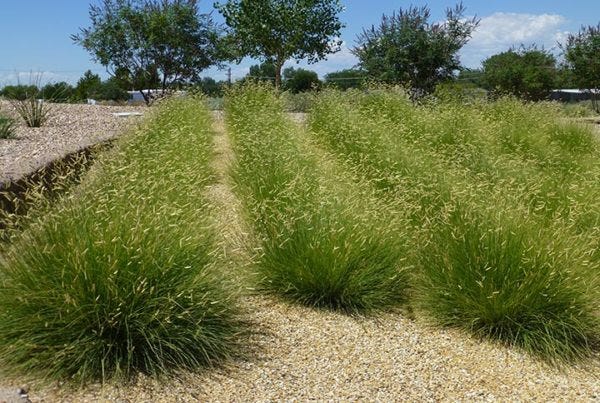Masses of Grass: Planting Large Groupings Of Ornamental Grasses
by David Salman

Chinese Maiden Hair Grass with a mass planting of Lavender
Ornamental grasses are some of our very best garden plants. They're low care perennials with a big impact on the look of our landscapes. With their fine-textured foliage, attractive flowers and seed heads, graceful movement in the breeze along with extended fall and winter beauty, they give us a remarkable visual contrast with flowering perennials, shrubs and other garden plants.
But ornamental grasses look best when used in larger numbers. How often do you see a prairie or meadow with just one grass plant?
Follow David Salman's recommendations for gorgeous mass plantings with Ornamental Grass. With these tips, you can create a breathtaking garden that is low maintenance, yet still has a major visual impact.

Ornamental Grass Garden with Nassella tenuissima and Little Bluestem grasses combine for an informal planting style at the Denver Botanic Garden in autumn.
Massing: Formal & Geometric, or Informal & Natural?
Grasses are accustomed to growing in groups, which in gardening terminology is referred to as "massing." Massing can also refer to planting large numbers of grass plants (without other non-grass plants) to create dramatic geometric 3-D patterns. This can be accomplished in both formal and informal ways. Grasses lend themselves to being planted in pleasing geometric patterns or simply grouped together in less formal arrangements.

Blonde Ambition Blue Grama Grass works for formal plantings as shown in this municipal landscape planting in New Mexico.
Designing Formal, Geometric Plantings With Grass
For structured plantings, follow these key guidelines:- Use long-lived species and cultivars. Short-lived varieties like blue Festuca ovina cultivars and Nassella (Silky Thread Grass) are not good choices.
- Use grasses that don't reseed themselves to any large extent. Otherwise, they quickly fill in between the original plants and destroy the planting pattern.
- Use grasses that grow as clumps, not ones that spread to create large mats via stolons (arching stems that push from the center of the grass and develop roots at the nodes where they touch the ground). Leymus arenarius and related species are "runners." These grasses are best used to cover slopes, beaches, and other larger areas.
- Stick with one grass variety to accentuate the visual impact by creating uniformity of the planting. However, two or three types of grasses can be combined by planting differently-sized grasses in geometric grid patterns that are placed side by side.

Blonde Ambition Blue Grama Grass planted with Pink Flamingo Mulhy Grass perfectly play off each other with their attractive foliage, and bright plumes.
Foer example, I've seen formal plantings of Nassella tenuissima (Silky Thread Grass) that for a couple of growing seasons, looked really nice. But Nassella is not a long-lived species, which for a geometric mass planting, is not good. By the third year, some of the original plants had died and there were a lot of volunteer seedlings that had filled in between the original plants. Thus the geometric unity of the design was ruined by gaps in the original grid and in-fill from volunteer seedlings.
Recommended Long-Lived, Low-Reseeding Grasses For Formal, Geometric Groupings:
- Bouteloua gracilis 'Blonde Ambition' (Blue Grama Grass)
- Calamagrostis acutiflora ('Karl Foerster' and variegated cultivars)(Feather Reed Grass)
- Helictotrichon sempervirens (Blue Avena Grass)
- Muhlenbergia dubia (Pine Muhly Grass)
- Muhlenbergia 'Pink Flamingo' (Hybrid Muhly Grass)
- Panicum virgatum cultivars ('Heavy Metal', 'Ruby Ribbons', 'Shenandoah'), Schizachyrium scoparium 'Standing Ovation' (Little Bluestem Grass)
- Sorghastrum nutans 'Thin Man' (Blue Indian Grass)

Caradonna Sage (Salvia) and Magnus Purple Coneflowercombine beautifully with Ruby Muhly Grass in this Sonoma, CA garden.
Designing Informal, Natural Plantings With Grass
For informal plantings, there is much more latitude. Informal designs allow the gardener to use a variety of grass species and cultivars, that are grouped in non-geometric patterns. Informal plantings accommodate shorter lived types, varieties that re-seed themselves and stoloniferous types along the edges. The gardener needs to do some "editing" each spring to thin out volunteer seedlings, so the planting doesn't become too dense and too much of a scrambled mixture.
There are so many possible combinations that will beautify the garden. But be sure that you used odd numbers of each grass (3,5,7) planted together. Mix the groups of one type with groups of other types. One each, of many different kinds of grass creates a hodge-podge design with no visual focal points on which the eye can rest. Use shorter types masses around groups of larger growers. It is also permissible to include groupings of larger growing perennial flowers to provide color and contrast. Prairie species of flowering perennials are always a good choice.

White Cloud Muhly Grass is a hard-to-find ornamental grass which thrives in both heat and humidity. This perennial grass is perfect for plantings of atleast three.
Recommended Grasses For Informal, Naturalizing Plantings:
Create habitat for butterfly/moth caterpillars and seed-eating songbirds by using native species and cultivars. Look for these grass species:
- Sorghastrum nutans (Indian Grass)
- Panicum virgatum (Prairie Switch Grass)
- Schizachyrium (Little Bluestem Grass)
- Andropogon (Big Bluestem Grass)
- Muhlenbergia (Muhly Grass)
- Bouteloua gracilis 'Blonde Ambition' (Blue Grama Grass)
- Sporobolus wrightii 'Windbreaker' (Giant Sacaton Grass)
- Muhlenbergia reverchoniii (Undaunted® Ruby Muhly)
Shop Ornamental Grass
Text and Photos by Founder and Chief Horticulturist David Salman.
© All articles are copyrighted by High Country Gardens. Republishing an entire High Country Gardens blog post or article is prohibited without written permission. Please feel free to share a short excerpt with a link back to the article on social media websites, such as Facebook and Pinterest.